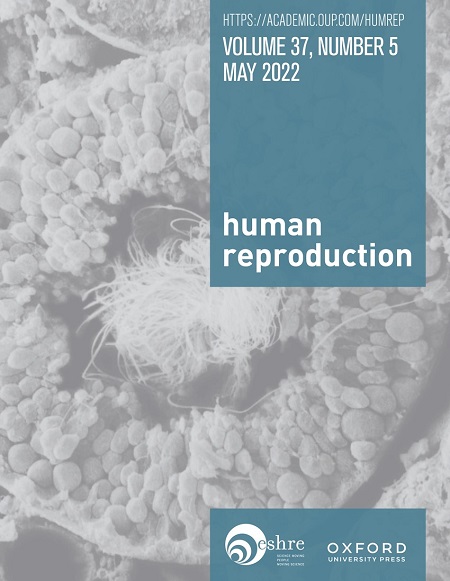Mapping the way to successful euploid frozen embryo transfer: a prospective pilot study of uterine elastography
IF 6
1区 医学
Q1 OBSTETRICS & GYNECOLOGY
引用次数: 0
Abstract
STUDY QUESTION Does the objective and quantitative assessment of uterine tissue stiffness via ultrasound shear wave elastography (SWE) predict the outcome after single euploid frozen embryo transfer (FET)? SUMMARY ANSWER Uterine SWE data might be predictive of clinical pregnancy in good prognosis patients undergoing single euploid FET. WHAT IS KNOWN ALREADY Few prior studies have evaluated the usefulness of strain uterine elastography in assessing the likelihood of conception in an infertile patient population following IUI or FET. These studies suggest that elastography parameters may be predictive of pregnancy following ART treatments. However, these studies are limited based on their use of strain uterine elastography, which provides a relative measurement between two areas of interest. No prior study has evaluated the more robust technology of SWE, which provides quantitative and objective measurements, on likelihood of conception following infertility treatment. STUDY DESIGN, SIZE, DURATION This is a prospective pilot study of 153 patients with no known uterine pathology undergoing single euploid FET at a university-affiliated center between June 2022 and December 2022. PARTICIPANTS/MATERIALS, SETTING, METHODS Patients scheduled for upcoming single euploid blastocyst FET during the study period were evaluated for study participation. On the day prior to embryo transfer, SWE assessment of 15 regions of interest of the sagittal uterus measuring 6 mm in diameter was performed on included participants. Regions of interest included the cervix, anterior/posterior distal myometrium, anterior/posterior lower uterine segment, fundus, endometrium, and the anterior myometrial/endometrial interface. The elastography data points generated were collected in a standardized fashion by a single investigator blinded to patient outcome. The elasticity parameters analyzed included the mean, SD, minimum, and maximum values in kilopascals and meters per second. These data were assessed for relationship to clinical pregnancy, defined as discharge from fertility care at 9 weeks’ gestation. MAIN RESULTS AND THE ROLE OF CHANCE There were 22 uterine elastography parameters that showed a significant relationship to clinical pregnancy with P < 0.10 using univariant analyses. Regions of interest that were predictive of clinical pregnancy with P < 0.10 included the cervix, the anterior myometrium, the posterior myometrium, the fundus, and the anterior myometrial/endometrial interface. Increased mean (stiffer elastography metrics) in the posterior myometrium and anterior myometrial/endometrial interface was associated with increased likelihood of clinical pregnancy in comparison to FETs that did not result in clinical pregnancy. These values were then subjected to a multivariable logistic regression model to estimate areas under the curves and predictive values with and without clinical parameters. Using elastography data only, the model for predicting clinical pregnancy resulted in a significant AUC of 0.826 (95% CI: 0.748, 0.904). Next, an additional model was generated using both elastography data and patient demographic and cycle characteristics, which also had a significant AUC of 0.923 (95% CI: 0.874, 0.973). Receiver operating characteristic curves were compared to demonstrate that SWE and clinical parameters together provide a significantly better predictive value compared with just clinical parameters alone to forecast clinical pregnancy. We then ran a 5× cross-validation, confirming that the system was robust. LIMITATIONS, REASONS FOR CAUTION There are several limitations to this study. The model developed is predictive of clinical pregnancy in a good prognosis patient population with high-quality euploid embryos, thereby limiting the generalizability of the model in alternative patient populations. Further work is needed to validate our findings in larger patient populations. Additionally, SWE data may be limited by patient parameters beyond the sonographer’s control. WIDER IMPLICATIONS OF THE FINDINGS Quantitative assessment of tissue elasticity using SWE of a morphologically normal uterus, assessed the day prior to single euploid FET, was found to result in a model predictive of clinical pregnancy in a good prognosis population. STUDY FUNDING/COMPETING INTEREST(S) Funding for this study was provided by IVIRMA Global. There are no conflicts of interest for any of the authors. TRIAL REGISTRATION NUMBER NCT05397912绘制整倍体冷冻胚胎移植的成功途径:子宫弹性成像的前瞻性先导研究
研究问题:超声剪切波弹性成像(SWE)对子宫组织硬度的客观定量评估能否预测单整倍体冷冻胚胎移植(FET)后的结果?子宫SWE数据可能预测预后良好的患者接受单整倍体FET的临床妊娠。很少有先前的研究评估应变子宫弹性成像在评估IUI或FET后不孕患者受孕可能性方面的有用性。这些研究表明弹性成像参数可以预测抗逆转录病毒治疗后的妊娠。然而,这些研究是有限的,基于他们使用应变子宫弹性成像,这提供了两个领域之间的相对测量感兴趣。之前没有研究评估过更强大的SWE技术,它提供了不孕症治疗后受孕可能性的定量和客观测量。研究设计、规模、持续时间:这是一项前瞻性先导研究,在2022年6月至2022年12月期间,153名没有已知子宫病理的患者在一所大学附属中心接受单倍体FET治疗。参与者/材料、环境、方法在研究期间评估即将进行单整倍体囊胚场效应晶体管的患者的研究参与情况。在胚胎移植前一天,对被纳入的参与者进行了直径为6毫米的矢状子宫15个感兴趣区域的SWE评估。感兴趣的区域包括子宫颈、前/后远端子宫肌层、前/后子宫段、眼底、子宫内膜和前子宫肌层/子宫内膜界面。产生的弹性成像数据点是由一名对患者结果不知情的研究者以标准化的方式收集的。所分析的弹性参数包括以千帕斯卡和米每秒为单位的平均值、标准差、最小值和最大值。这些数据被评估为与临床妊娠的关系,定义为妊娠9周从生育护理出院。主要结果及机会的作用子宫弹性图参数22项与临床妊娠P &;lt;0.10使用单变量分析。预测临床妊娠P &;lt;0.10包括子宫颈、前子宫肌层、后子宫肌层、眼底和前子宫肌层/子宫内膜界面。与未导致临床妊娠的fet相比,后子宫肌层和前子宫肌层/子宫内膜界面的平均值(更硬的弹性图指标)增加与临床妊娠的可能性增加有关。然后将这些值纳入多变量逻辑回归模型,以估计曲线下的面积以及有无临床参数的预测值。仅使用弹性成像数据,该模型预测临床妊娠的AUC为0.826 (95% CI: 0.748, 0.904)。接下来,使用弹性图数据和患者人口统计学和周期特征生成了一个额外的模型,该模型的AUC也显著为0.923 (95% CI: 0.874, 0.973)。比较受试者工作特征曲线,发现SWE与临床参数联合预测临床妊娠的预测价值明显优于单纯临床参数。然后我们进行了5次交叉验证,确认系统是健壮的。局限性,谨慎的原因本研究有几个局限性。该模型可以预测具有高质量整倍体胚胎的预后良好的患者群体的临床妊娠,从而限制了该模型在其他患者群体中的普遍性。需要进一步的工作来在更大的患者群体中验证我们的发现。此外,SWE数据可能受到超出超声医师控制的患者参数的限制。使用形态学正常子宫的SWE定量评估组织弹性,在单个整倍体FET前一天进行评估,发现在预后良好的人群中产生预测临床妊娠的模型。研究资金/竞争利益本研究的资金由IVIRMA Global提供。任何作者都没有利益冲突。试验注册号nct05397912
本文章由计算机程序翻译,如有差异,请以英文原文为准。
求助全文
约1分钟内获得全文
求助全文
来源期刊

Human reproduction
医学-妇产科学
CiteScore
10.90
自引率
6.60%
发文量
1369
审稿时长
1 months
期刊介绍:
Human Reproduction features full-length, peer-reviewed papers reporting original research, concise clinical case reports, as well as opinions and debates on topical issues.
Papers published cover the clinical science and medical aspects of reproductive physiology, pathology and endocrinology; including andrology, gonad function, gametogenesis, fertilization, embryo development, implantation, early pregnancy, genetics, genetic diagnosis, oncology, infectious disease, surgery, contraception, infertility treatment, psychology, ethics and social issues.
 求助内容:
求助内容: 应助结果提醒方式:
应助结果提醒方式:


